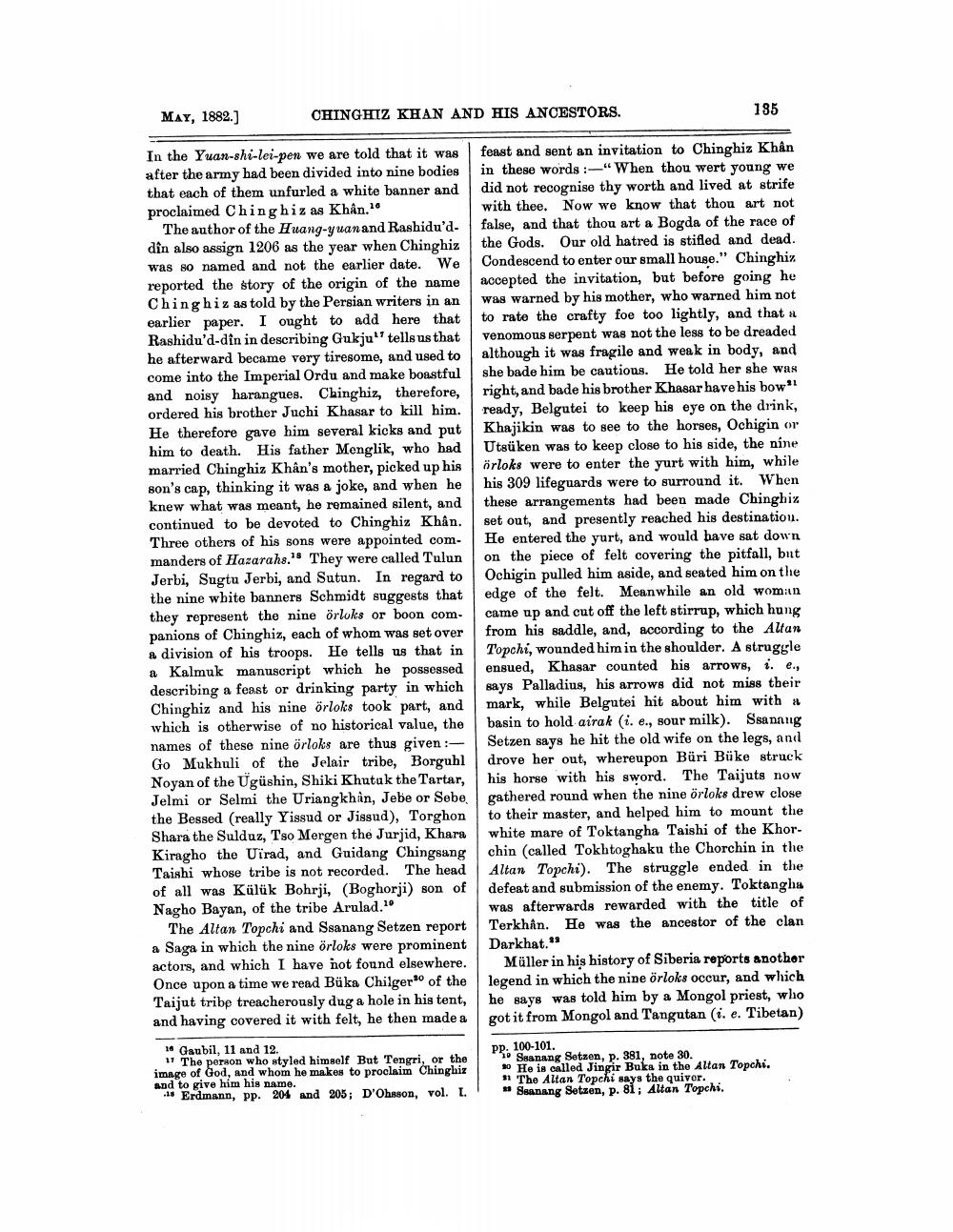________________
MAY, 1882.)
CHINGHIZ KHAN AND HIS ANCESTORS.
185
In the Yuan-shi-lei-pen we are told that it was after the army had been divided into nine bodies that each of them unfurled a white banner and proclaimed Chinghiz as Khân.
The author of the Huang-yuanand Rashidu'ddîn also assign 1206 as the year when Chinghiz was so named and not the earlier date. We reported the story of the origin of the name Chinghiz as told by the Persian writers in an earlier paper. I ought to add here that Rashidu'd-din in describing Gukju" tells us that he afterward became very tiresome, and used to come into the Imperial Ordu and make boastful and noisy harangues. Chinghiz, therefore, ordered his brother Juchi Khasar to kill him. He therefore gave him several kicks and put him to death. His father Menglik, who had married Chinghiz Khan's mother, picked up his son's cap, thinking it was a joke, and when he knew what was meant, he remained silent, and continued to be devoted to Chinghiz Khân. Three others of his sons were appointed commanders of Hazarahs." They were called Tulun Jerbi, Sugtu Jerbi, and Sutun. In regard to the nine white banners Schmidt suggests that they represent the nine örloks or boon companions of Chinghiz, each of whom was set over a division of his troops. He tells us that in a Kalmuk manuscript which he possessed describing a feast or drinking party in which Chinghiz and his nine örloks took part, and which is otherwise of no historical value, the names of these nine örloks are thus given :Go Mukhuli of the Jelair tribe, Borguhl Noyan of the Ugüshin, Shiki Khutuk the Tartar, Jelmi or Selmi the Uriangkhan, Jebe or Sebe the Bessed (really Yissud or Jissud), Torghon Shara the Sulduz, Tso Mergen the Jurjid, Khara Kiragho the Uirad, and Guidang Chingsang Taishi whose tribe is not recorded. The head of all was Külük Bohrji, (Boghorji) son of Nagho Bayan, of the tribe Arulad.
The Altan Topchi and Ssanang Setzen report a Saga in which the nine örloks were prominent actors, and which I have not found elsewhere. Once upon a time we read Büka Chilger*o of the Taijut tribe treacherously dug a hole in his tent, and having covered it with felt, he then made a
feast and sent an invitation to Chinghiz Khân in these words :-“When thou wert young we did not recognise thy worth and lived at strife with thee. Now we know that thou art not false, and that thou art a Bogda of the race of the Gods. Our old hatred is stifled and dead. Condescend to enter our small house." Chinghix accepted the invitation, but before going he Was warned by his mother, who warned him not to rate the crafty foe too lightly, and that a venomous serpent was not the less to be dreaded although it was fragile and weak in body, and she bade him be cautious. He told her she was right, and bade his brother Khasar have his bow"! ready, Belgutei to keep his eye on the drink, Khajikin was to see to the horses, Ochigin or Utsüken was to keep close to his side, the nine örloks were to enter the yurt with him, while his 309 lifeguards were to surround it. When these arrangements had been made Chinghix set out, and presently reached his destination. He entered the yurt, and would have sat down on the piece of felt covering the pitfall, but Ochigin pulled him aside, and seated him on the edge of the felt. Meanwhile an old wom:in came up and cut off the left stirrup, which hung from his saddle, and, according to the Altan Topchi, wounded him in the shoulder. A struggle ensued, Khasar counted his arrows, i. e., says Palladius, his arrows did not miss their mark, while Belgutei hit about him with basin to hold airak (i. e., sour milk). Ssanang Setzen says he hit the old wife on the legs, and drove her out, whereupon Büri Büke struck his horse with his sword. The Taijuts now gathered round when the nine örloks drew close to their master, and helped him to mount the white mare of Toktangha Taishi of the Khorchin (called Tokhtoghaku the Chorchin in the Altan Topchi). The struggle ended in the defeat and submission of the enemy. Toktanghu was afterwards rewarded with the title of Terkhân. He was the ancestor of the clan Darkhat."
Müller in his history of Siberia reports anothor legend in which the nine örloks occur, and which he says was told him by a Mongol priest, who got it from Mongol and Tangutan (ie. Tibetan)
Gaubil, 11 and 12. 11 The person who styled himself But Tengri, or the image of God, and whom he makes to proclaim Chinghiz and to give him his name. ..Erdmann, pp. 204 and 205; D'Ohason, vol. I.
pp. 100-101.
• Saanang Setzen, p. 381, note 30. # He is called Jingir Buka in the Altan Topchi. * The Altan Topchi says the quiver. * Seanang Setzen, p. 81; Altan Topchi.




